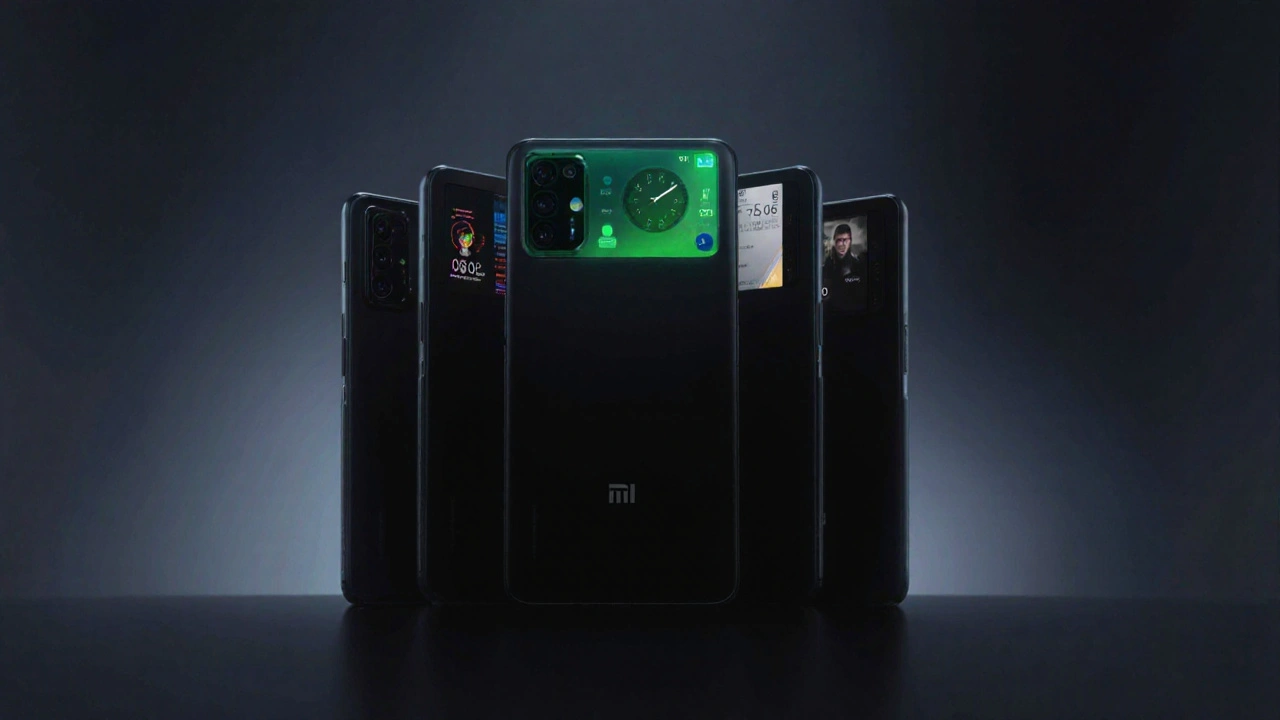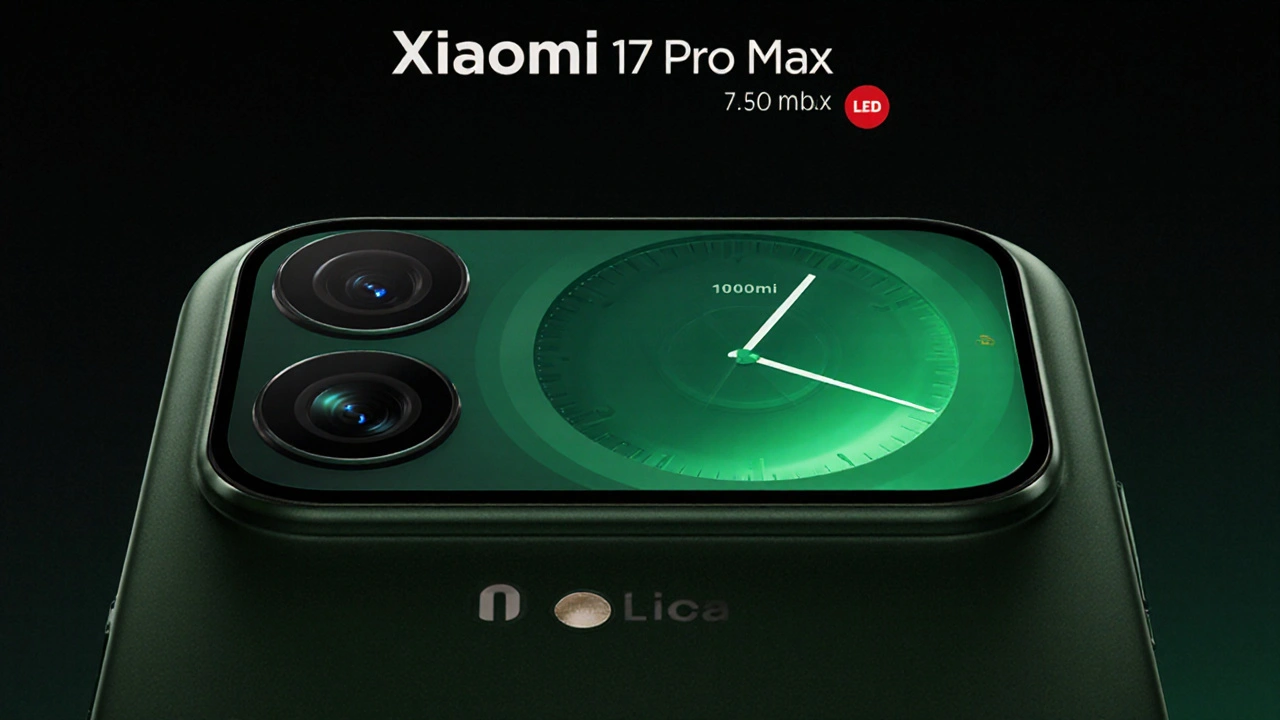Design, Display and Battery Power
When Xiaomi announced the Xiaomi 17 Pro Max in September 2025, the headline was hard to miss: a 7,500 mAh battery that dwarfs typical flagship capacities. That’s a full 2,000 mAh more than the Galaxy S25 Ultra and far beyond the iPhone 17 Pro Max’s 4,500 mAh cell. The company backs the massive pack with 100W wireless charging and a 50W wired fast‑charge system, promising a full charge in under thirty minutes.
The phone’s 6.9‑inch flat LTPO AMOLED panel pushes the envelope on brightness, hitting a staggering 3,500 nits at peak. In practical terms, you can read a screen outdoors at noon without squinting. The QHD resolution (1220 × 2656) delivers crisp detail at 463 ppi, and the 120Hz refresh rate makes scrolling feel buttery smooth. Despite the hefty battery, Xiaomi says the 17 Pro Max is lighter than Apple’s latest flagship – a claim that will be tested in real‑world hands‑on sessions.
One of the quirkiest design moves is the addition of a secondary rear display. It’s a modest‑sized screen that can show notifications, shortcuts, or serve as a gaming map. Xiaomi bundles a custom case that turns the back screen into a tactile control surface, aiming to give mobile gamers a new way to interact without covering the main screen.

Performance, Camera and Unique Features
Under the hood, the phone runs the brand‑new Qualcomm Snapdragon 8 Elite Gen 5, built on a 3nm process. Early benchmarks suggest it outperforms the previous generation by double‑digit percentages, especially in AI‑heavy tasks and gaming. Paired with 16 GB of LPDDR5X RAM and up to 1 TB of UFS 4.0 storage, the device feels responsive even when juggling multiple high‑resolution video streams.
The camera suite is a triple 50 MP Leica‑branded system. Xiaomi highlights a larger sensor size for the primary lens, promising better low‑light performance and reduced noise. The Pro Max version includes a 5x periscope telephoto lens, expanding the optical zoom range without the quality loss you see in digital zoom. Early sample photos show vivid colors and solid detail, though the true test will be how the software processes motion and portrait shots.
Beyond the raw specs, Xiaomi is betting on the rear display to set the 17 Pro Max apart. The accessory case incorporates programmable buttons that map to the back screen, giving gamers a dual‑controller feel. For everyday users, the rear screen can double as a quick‑glance widget hub, showing weather, music controls, or a silent alarm without unlocking the phone.
All these elements combine to position Xiaomi as a serious challenger in the premium arena. The massive battery addresses a common gripe among power users – needing to charge daily – while the Snapdragon 8 Elite and Leica optics aim to match or exceed the performance of Samsung and Apple’s flagships. Whether the market will embrace a phone that’s heavier yet lighter than rivals, and that carries a rear screen, remains to be seen, but the 17 Pro Max certainly reshapes expectations for what a flagship can offer.

Chance Remien
September 27, 2025 AT 04:35Battery life is the backbone of modern mobile usage. A 7,500 mAh pack theoretically eliminates daily charging anxieties for power‑hungry users. Coupled with 100 W wireless and 50 W wired fast charging, the device promises a full charge in under thirty minutes, which aligns with productive workflows. From a philosophical standpoint, extending autonomy through energy translates to less friction in daily routines. Therefore, the battery specification alone warrants serious consideration.
Anna Lee
September 29, 2025 AT 12:09Wow!!! This phone looks insane!!! The 3,500‑nit screen is gonna make every other phone look like a dim flashlight!!! And that rear‑side display? Definately a game‑changer for us gamers!!! I cant wait to slap that custom case on and feel the extra buttons under my thumb!!!
Daniel Craine
October 1, 2025 AT 19:42Battery bragging can't hide the average camera quality.
Kristen VanPamel
October 4, 2025 AT 03:15The rear screen is a gimmick that adds weight without real utility.
Liz Lessner
October 5, 2025 AT 07:02Yeah, the extra screen sounds fun but make sure it doesn't drain the huge battery too fast. If the software is efficient you’ll still get all‑day use, otherwise it could become a novelty you turn off.
Reid Vance
October 7, 2025 AT 14:35What sets this device apart is the Snapdragon 8 Elite Gen 5 built on a 3 nm process, delivering double‑digit performance gains over the previous generation. Pair that with 16 GB of LPDDR5X RAM and up to 1 TB of UFS 4.0 storage, and you have a machine that can handle any multitasking scenario you throw at it. The integration of Leica‑branded optics further elevates the photographic capabilities, making it a legitimate contender against Samsung and Apple.
Javier cox
October 9, 2025 AT 22:09yeah dude the specs sound lit but i wonder how the heat management will be when you push that chip hard. if it gets too hot the whole experience could nosedive.
Giacinta Pace
October 12, 2025 AT 05:42This phone could be a great choice for people who hate charging all the time. Big battery, fast charge, and cool screen – sounds like a win.
darryl archer
October 14, 2025 AT 13:15In the annals of mobile innovation, Xiaomi's audacious foray into ultra‑high capacity battery design represents a paradigmatic shift. The confluence of an expansive 7,500 mAh cell with a 3,500‑nit LTPO panel bespeaks a commitment to both endurance and visual fidelity that few competitors can parallel.
Dina DiCicco
October 16, 2025 AT 20:49Totally agree 🙌 The blend of power and brilliance is impressive 🤩
Kasey DellaPenna
October 19, 2025 AT 04:22The rear display could be useful for quick glances at notifications or music controls but it might also be a distraction for some users.
Gayleen Lowrie
October 21, 2025 AT 11:55distractions are fine if you can turn it off when not needed
Wesley Nakamatsu
October 23, 2025 AT 19:29American tech leadership thrives on pushing boundaries, and this device exemplifies the spirit of innovation that keeps the nation at the forefront of global competition.
Tyler Tucker
October 26, 2025 AT 02:02Too much hype this phone is just another battery bragfest and will never beat true flagship quality
julia mutambara
October 28, 2025 AT 09:35When evaluating a flagship smartphone, the battery capacity is often the first metric that catches the eye, and Xiaomi's 7,500 mAh unit certainly stands out among its peers. The promise of a full charge in under thirty minutes, thanks to 100 W wireless and 50 W wired fast charging, suggests a level of convenience that could redefine daily usage patterns. In practical terms, a user could start the day with a quick charge, attend multiple meetings, and still have enough juice to stream high‑resolution video in the evening without reaching for an outlet. Moreover, the 6.9‑inch flat LTPO AMOLED display, boasting a peak brightness of 3,500 nits, ensures that outdoor readability is no longer a compromise, eliminating the need for constant screen adjustments. The QHD resolution paired with a 120 Hz refresh rate offers a buttery‑smooth visual experience that benefits both gamers and productivity users alike. Under the hood, the Snapdragon 8 Elite Gen 5, fabricated on a 3 nm process, provides a noticeable uplift in AI processing and gaming performance compared to the previous generation, allowing for smoother frame rates and quicker scene rendering. Coupled with 16 GB of LPDDR5X RAM, the phone can juggle multiple demanding applications without stuttering, which is a critical factor for power users who rely on multitasking. The inclusion of up to 1 TB of UFS 4.0 storage further future‑proofs the device, accommodating large media libraries and high‑resolution recordings. Photographically, the triple 50 MP Leica‑branded camera system introduces a larger sensor that promises improved low‑light performance and more accurate colour reproduction, while the 5× periscope telephoto lens adds genuine optical zoom without the degradation seen in digital alternatives. The secondary rear display, though quirky, could serve as a contextual widget hub, delivering weather updates, music controls, or silent alarms without unlocking the main screen, which might appeal to users seeking quick information at a glance. From a design perspective, Xiaomi claims the device is lighter than the iPhone 17 Pro Max, a statement that will need verification through hands‑on testing, especially given the additional weight of the massive battery. The custom case that transforms the back screen into programmable tactile controls could revolutionise mobile gaming ergonomics, offering a dual‑controller feel while keeping both hands on the device. However, this innovation may also introduce new learning curves and potential accidental inputs, which could affect user adoption. Overall, the Xiaomi 17 Pro Max assembles an impressive suite of specifications that challenge the established giants, and its success will largely depend on software optimisation, real‑world ergonomics, and consumer willingness to embrace a slightly larger form factor. In conclusion, the device not only reshapes expectations for battery endurance but also pushes the envelope on display brilliance, performance horsepower, and novel user interactions, making it a compelling contender in the premium smartphone arena.
Nelleke Elston
October 30, 2025 AT 17:09While the specs read like a checklist for a flagship, the reality is that most users will never tap the rear screen or need 3,500 nits, so this could be over‑engineered for the average consumer.
subhashree mohapatra
November 2, 2025 AT 00:42The device sounds impressive on paper, yet the real test will be thermal performance under sustained load and how the software handles battery optimisation; without thorough testing, the hype remains speculative.